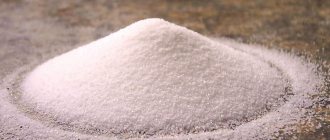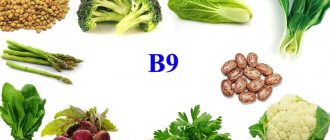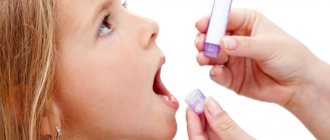Author of the article
Vereshchak Vladimir Vasilievich
Otolaryngologist (ENT) of the first category
Articles written
704
about the author
Allergy to Miramistin often occurs in children, less often in adults. Individual intolerance is caused by immune rejection of certain components of the drug. The patient develops unpleasant clinical signs upon contact with the irritant: on the skin, the respiratory tract and digestive tract are affected. The text talks about ways to combat the disease, its causes, symptoms.
Allergy to miramistin in children and adults: can it happen, symptoms and what to do
Miramistin is one of the most popular antiseptics, which also has anti-inflammatory and antimicrobial effects. The drug is prescribed in the following cases:
- Purulent wounds, burns.
- Diseases caused by viruses: herpes, syphilis, gonorrhea, etc.
- Otitis, tonsillitis, sinusitis.
- Fungal infections of the skin and mucous membranes (candidiasis, mycoses)
- In dentistry for stomatitis, periodontitis.
- Bacterial diseases.
Miramistin is currently practically a universal remedy for many diseases. Such a wide spectrum of action is due to the mechanism of action of the drug: destruction of the membrane of living cells of microorganisms, which leads to their death. At the same time, it does not damage the cells of the human body and rarely causes allergic reactions and irritations. But is this drug really safe?
Can you be allergic to Miramistin?
Like any medicine, Miramistin can cause allergies. Side effects may also include a burning sensation in the area of application and redness.
An allergic reaction rarely develops in patients and is most often associated with improper use of the drug or intolerance to one of the components, for example, benzyldimethylammonium chloride.
In order to exclude adverse reactions as a result of an overdose of Miramistin, the ointment should be applied in a thin layer, gently rubbing into the skin or mucous membranes. When treating diseases of the reproductive system, correct dosage is a mandatory requirement.
Symptoms and causes of allergies to Miramistin
Allergies are caused by the body's response to the drug. This may be due to hypersensitivity, genetic predisposition, sensitivity to the components of the drug, or overdose.
The most common cause of burning and redness is an overdose . The drug should be applied in the form of a spray or ointment as prescribed by a doctor or as indicated in the instructions. The frequency of administration should be observed. Excessive use of Miramistin will not lead to a faster recovery, but on the contrary, may contribute to the development of allergies.
- Burning.
- Focal redness of the skin at the site of application.
- Cough, runny nose, sore throat.
- Itching.
The second common manifestation of an allergic reaction is itching. It develops in the area where the medicine is applied several hours after application. Cough and runny nose are extremely rare in patients.
Allergy to Miramistin in infants and children
The use of the drug is allowed from the age of three years, but doctors prescribe it from the age of 6-8 months. Most often, Miramistin is used for infectious diseases of the nasopharynx, pustular wounds, and fungal infections of the throat.
The manifestation of allergies in children is more pronounced than in adults - severe redness at the site of application, burning. If redness occurs, you should stop using the drug.
To determine the reaction to Miramistin in an infant, apply the drug with a swab to a small area of skin and wait about 4 hours. If there is no redness, the child is not allergic to the components of the drug. The main requirement is compliance with the regimen of use, especially when using the drug in the form of an ointment.
Diagnosis and treatment of allergies
Diagnosing an allergy is not difficult; it is much more difficult to find out the reason that led to its occurrence. To do this, you need to see an allergist and take the necessary tests. Testing will determine the body's reactivity and will allow the patient to further eliminate contact with allergens.
Treatment is based on symptoms. The very first thing to do is to stop taking the drug . Replacing Miramistin with an analogue is possible only after finding out why the reaction developed. Many analogues contain the same active ingredient as Miramistin, and therefore the allergy will occur again when taking the analogue.
Best choice: cream for atopic dermatitis
Prevention in children and adults
There is no prevention against allergic reactions as such. checking the body’s reaction before using a new drug, especially in children and infants . Miramistin is used externally only, so you can check the reaction by applying a small amount of ointment or spray to an intact area of skin. If there is no reaction within several hours, the risk of developing an allergy is minimal.
For what diseases should Miramistin be used?
- ENT diseases: pharyngitis, tonsillitis, sore throat, sinusitis, otitis media, laryngitis.
- In dentistry: for herpes stomatitis, periodontitis, gingivitis, periodontitis, for disinfection of dentures.
- In dermatology: for purulent superficial wounds, herpes skin rashes, dermatomycosis, candidiasis.
- In gynecology and obstetrics: for wounds and injuries during childbirth, for the treatment of infectious and inflammatory processes of the genital organs.
- In surgery: for purulent and inflammatory processes in the musculoskeletal system, wounds.
- In urology: for the treatment of urethritis and urethroprostatitis.
The product is also applicable for burns and as a preventive measure to protect against infections transmitted through sexual contact.
The composition of Miramistin spray contains: distilled water, benzyl-dimethyl (3-myristoyl-aminopropyl) and ammonium chloride monohydrate.
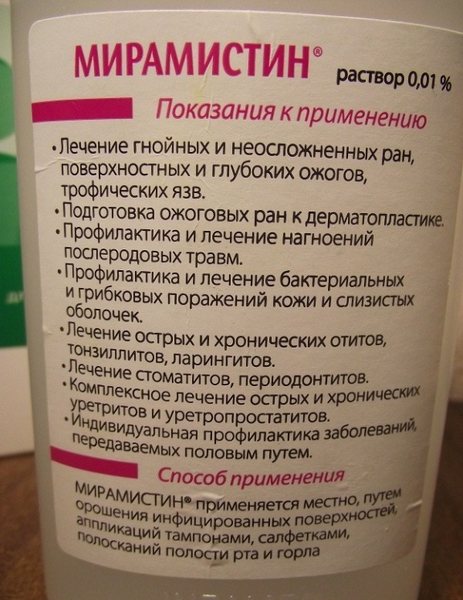
Individual sensitivity to the components of Miramistin.
Side effects of the solution : a brief slight burning sensation may be felt at the site of application of the drug.
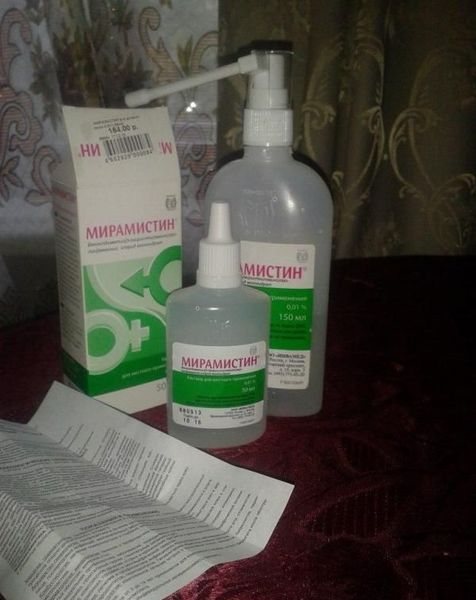
Before using Miramistin, remove the cap from the bottle, take out the sprinkler nozzle and attach it to the bottle. After this, the nozzle is activated by double-clicking on it.
To treat burn areas and wounds, it is more convenient to use a spray, but you can make applications with a solution.
To treat postpartum injuries, vaginal irrigation is done for 5-7 days. During a caesarean section, the vagina, uterine cavity and postoperative suture are treated. In the postoperative period of 7 days, tampons with Miramistin are used as suppositories. Keep the candles for 2 hours.
For purulent sinusitis, the medicine is used to rinse the maxillary sinus.
For the throat , in case of inflammatory processes, a spray is used, which is used to irrigate the mucous membrane 3-4 times a day. One click of the nozzle releases up to 4 ml of medication. For rinsing, take 10-15 ml per procedure, duration – 1 minute.
For children under 7 years of age, if they have a sore throat, do it 3-4 times a day, 1 click at a time. From 7 years old – 2 clicks. The course of treatment is no longer than 10 days.

For angina, Miramistin is used by adults and children from 3 years of age as a rinse or solution for inhalation. Number of procedures – up to 5 per day. When using a nebulizer for inhalation for a child, you should first consult a doctor. Very small particles when sprayed can cause allergies.
is instilled into the nose only as prescribed by a specialist; for children under 2 years of age, it is advisable not to use it. The solution may irritate the mucous membranes and cause an increase in runny nose.
For diseases of a dental nature ( candidal stomatitis, gingivitis ), children under one year of age are treated with wiping the inflamed mucous membrane with a gauze swab. From the age of 3 years, the medicine is used as a spray - you need to spray it in the throat and on damaged areas of the mucous membrane once 4 times a day. From 6-7 years of age, Miramistin is used for rinsing - 10 ml per procedure, also 4 times a day.
The drug is used to treat areas with acne .
The use of a special urological nozzle allows Miramistin to be injected into the urethra to treat urethritis and urethroprostatitis . For one procedure, 2-3 ml of liquid is taken. Injections are done up to 2 times a day for 7-10 days.
Prevention of sexually transmitted diseases : no later than 2 hours after sexual contact, 3 ml of Miramistin is injected into the urethra for 3 minutes for men, 2 ml for women and up to 10 ml into the vagina. The skin of the genital organs and thighs is also treated.
For candidiasis in women, tampons with the drug are placed up to 3 times a day and douching is performed. The course of treatment is up to 10 days.
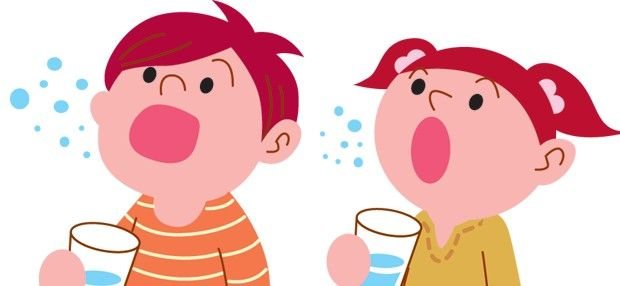
At what age can the solution be used? The instructions say from 3 years of age. But if the obvious benefits outweigh the risks and the treating pediatrician allows the use of Miramistin, then it is used with caution. Children under one year of age are most dangerous; the liquid can dry out mucous membranes, cause irritation, burns or allergies. So for babies it is better to take other, more gentle antiseptics.
You can gargle a sore throat with Miramistin from the age of 6-7, when the child begins to understand the essence of the action. You can also put drops in your nose or ears, but only after consulting a doctor.
The solution should not be applied to the nipple as the baby may swallow it. You need to wipe your mouth with a moderately moistened gauze swab so that the child does not swallow it.
If the gums become red, there is pain, a burning sensation - this is a manifestation of gingivitis or periodontitis, a complex inflammatory process.
For gingivitis and periodontitis, Miramistin should not be used as the main drug for treatment, but as an auxiliary therapy. The inflammation itself is caused by soft and hard bacterial plaque and without cleaning there will be no point in such treatment. Only after ultrasonic cleaning can you start rinsing and applying Cholisal gel.
If you start therapy with the drug immediately (without removing plaque and stones), the result will appear and the inflammation will decrease, but recovery will not occur. The disease will simply turn into a chronic, imperceptible form.
Compared to Chlorhexedine, the antiseptic is more expensive.
Approximately how much Miramistin costs:
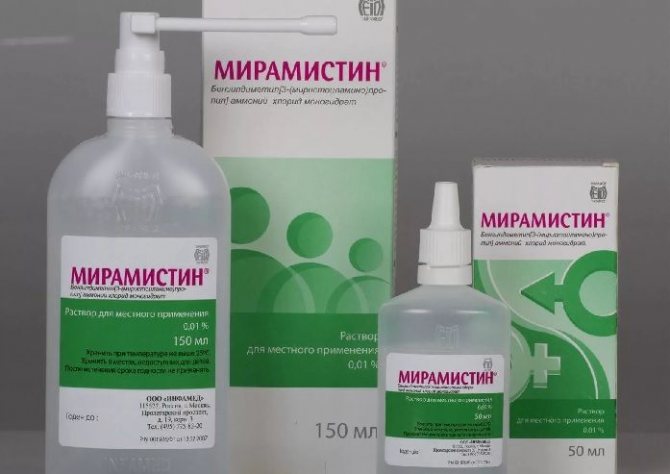
Is it possible to get poisoned with Miramistin? This condition is extremely rare. The drug is used for local treatment of the mucous membranes of the oral cavity and for gargling, so the dose of the drug ingested is minimal and cannot lead to any negative consequences. It is important to note that the medication is used for treatment in all age groups.
Only two substances are contained in the medicine:
- Miramistin, which is the directly active therapeutic component.
- Distilled water.
The drug belongs to the group of local disinfectants; it destroys most known infectious agents belonging to various classes: bacteria, fungi or viruses.
According to scientific research, the spectrum of action of Miramistin is wide, which leads to its frequent use in medical practice for treating mucous membranes, rinsing the mouth or disinfecting damaged skin. It is believed that the medication is safe for the human body and does not cause side effects except for a local allergic reaction.
Find out why a rash appears after poisoning: causes and treatment.
What to do if weakness appears after poisoning: treatment during the recovery period.
The medicine has many indications due to its disinfectant effect. As a rule, the drug is used for inflammatory or infectious processes on the skin or mucous membranes. For this purpose, the mucous membranes of the oral or nasal cavity, as well as the throat, can be irrigated with Miramistin.
The drug is used in urology and gynecology for the treatment of superficial urogenital infections. It is important to note that the use of local treatment alone does not lead to complete recovery of the patient. Therefore, Miramistin in therapy is always combined with other drugs that have a systemic effect.
When used in gynecology, the medicine is syringed into the vaginal cavity. This is necessary for the local treatment of thrush or inflammatory diseases. Men use Miramistin to treat urethritis, both specific and nonspecific.
In addition to allergic reactions to the active substance, dry mucous membranes or skin may occur while taking the drug. This symptom persists for several days, and quickly disappears when the medication is discontinued.
Overdose of Miramistin is a rare situation. More often, when using the medication, allergic reactions of varying severity are observed when the body is sensitized to the active substance.
The main manifestations of such an allergy on the mucous membranes and skin are redness or rashes like urticaria. Such cases do not require seeking medical help or complex treatment. Use of any antihistamines: Suprastin (see Suprastin poisoning), Erius. Discontinuation of the drug allows you to quickly get rid of redness or hives.
The most common form of Miramistin, sold in pharmacies and used by patients, is a plastic bottle with a nozzle. It is important for patients to know that if they plan to use a disinfectant for douching the genitals, then they need to purchase a special nozzle that facilitates such manipulations.
However, polyethylene bottles are not the only form of drug release. Ointments with Miramistin are also available. They are mainly used to treat fungal infections of the oral cavity and mucous membranes of the reproductive system. The ointment is easily applied to the mucous membranes and has a pronounced antibacterial and antifungal effect.
When choosing a specific form of medication, it is better to seek help from a doctor. Diseases of such localizations can lead to serious complications and progress rapidly. Therefore, it is better if Miramistin and the frequency of its administration are prescribed by a doctor.
Any drug has side effects. Miramistin is no exception in this regard. Most often, patients experience local irritation of the mucous membrane or damaged skin, manifested by burning and tingling in this area. Excessive pain when using an antiseptic indicates a severe bacterial process in the mucous membrane.

It is important to understand that this burning and tingling sensation is a normal reaction of the surface tissues of our body to the use of a disinfectant. Miramistin does not leave burns even when used in children if used correctly. If suspicions of damage to the skin or mucous membrane remain, then you can go to a medical institution to see a doctor who will conduct an examination and, if necessary, prescribe treatment (see How much poisoning is treated in a hospital).
Miramistin is a topical drug that excludes the systemic effect of the drug and its absorption into the blood. A large number of studies have been conducted on animals and volunteers, showing that the medicine has a high degree of safety and does not lead to an overdose of Miramistin in children and adults.
Careful study of the instructions for use in the section on the method of using the drug and preventing the development of adverse drug reactions allows you to prevent possible cases of overdose.
With frequent and inadequate irrigation of the mucous membranes of the oral or nasal cavity, the drug enters in large quantities and leads to an overdose, causing symptoms of gastrointestinal disorders (see Vomiting in case of poisoning). However, in practice, not a single case of overdose in a patient of any age has been recorded.
Find out why convulsions occur during poisoning: causes and treatment of convulsive syndrome.
Read why the body aches when poisoned: causes, diagnosis, treatment.
To prevent overdose, follow the recommendations:
- When irrigating or rinsing the mouth, the drug must be spat out without swallowing. This avoids nausea and vomiting. However, for serious stomach disorders to occur, the dose of the drug taken must be very large.
- The medicine must be stored out of the reach of children, since a child can take out the bottle and drink it. No such cases have been recorded, however, theoretically this could cause an overdose.
Following these tips will significantly reduce the risk of unwanted symptoms when using the drug.
Overdose of Miramistin is an unlikely condition due to the peculiarities of use of the drug and the small dose of the active substance when used. In any case, if any symptoms appear while using the medication (see Help with drug poisoning), you should stop using it and consult your doctor.
Post Views: 253
How to identify an allergen?
Certain diagnostic methods will help identify what has become the allergen.
Initially, the patient should consult a doctor. At the appointment, he conducts a visual examination and takes into account the patient’s complaints. Conduct skin tests and allergy tests. They help identify the irritant if a child has an allergy. Laboratory tests are prescribed in almost every case. They help to more accurately identify the provocateur. A general blood test and an immunological blood test are performed. You can determine this disease yourself. The first signs of a reaction appear a few hours after using the medicine.
Allergy to Miramistin in infants and children
The use of the drug is allowed from the age of three years, but doctors prescribe it from the age of 6-8 months. Most often, Miramistin is used for infectious diseases of the nasopharynx, pustular wounds, and fungal infections of the throat.
The manifestation of allergies in children is more pronounced than in adults - severe redness at the site of application, burning. If redness occurs, you should stop using the drug.
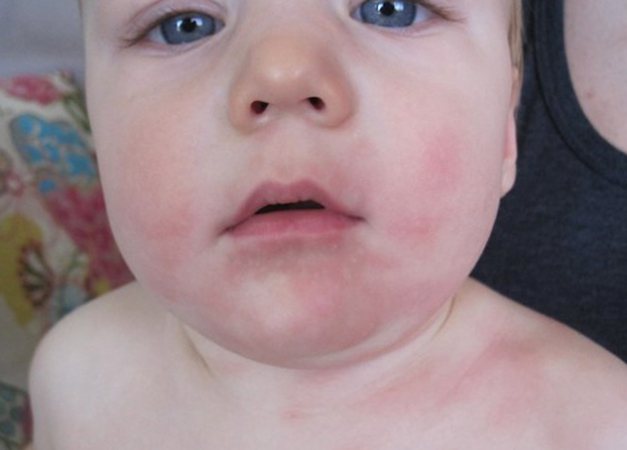
To determine the reaction to Miramistin in an infant, apply the drug with a swab to a small area of skin and wait about 4 hours. If there is no redness, the child is not allergic to the components of the drug. The main requirement is compliance with the regimen of use, especially when using the drug in the form of an ointment.
Predisposing factors
Although an allergy to miramistin is a fairly rare occurrence, there are a number of factors that potentially provoke the occurrence of clinical symptoms:
- Young and children's age
- Female gender (due to hormonal instability)
- The presence of a genetic predisposition to atopy (drug hypersensitivity in both parents gives a 70% chance of allergies in the child)
- Associated infectious diseases (Epstein-Barr virus)
- Frequent local use of the drug
- Use of doses above the average therapeutic
Therapeutic measures
When Miramistin causes an allergy, it is important to stop using it first. If you continue to take the medicine, you can provoke a more severe development of allergies. With prolonged use against the background of developed pathology, anaphylactic shock or Quincke's edema may appear. Therefore, it is necessary to consult a doctor as soon as possible to select medications that eliminate the manifestations and replace the active action of Miramistin itself. If allergies provoke various types of serious complications, emergency hospitalization will be required.
If you cannot visit a specialist for treatment as soon as possible, you can resort to using a number of home methods to combat allergies:
- anti-inflammatory: decoction, infusion, lotions with chamomile, sage, string;
- Relieving itching: a solution of soda with iodine (a few drops), followed by sunflower oil and water.

At an appointment with an allergist, after collecting complaints, examining and performing additional examination, a comprehensive treatment plan is developed. This is not always required, since even the abolition of Miramistin allows the body’s condition to normalize after some time.
In some cases, it is still necessary to prescribe a number of medications that eliminate the symptoms of allergic manifestations:
- non-steroidal anti-inflammatory drugs;
- corticosteroids;
- sorbents;
- complexes of vitamins and minerals;
- To locally eliminate hypersensitivity reactions, ointments and gels (Fenistil gel) are prescribed.
Preventive measures
If allergic reactions to Miramistin occur, it is important to adhere to a number of simple rules in order to prevent complications:
- Refusal from further use and replacement with an analogue;
- Consult a doctor for advice;
- Stop drinking alcohol and smoking or minimize it;
- If adults are allergic to Miramistin, then it is advisable to review the features of the daily diet. You should remove all foods that can stimulate the development of pathology (fatty, fried, citrus fruits, sweets);
- To maintain water-salt balance, it is important to drink at least 1.5-2 liters of plain water per day.
In general, it can be noted that an allergy to Miramistin can occur extremely rarely. When it occurs, it is important to eliminate the unpleasant symptoms of the lesion, replace the medication and adjust the diet. If all the listed basic recommendations are followed, manifestations, if any, will be to an insignificant extent.
Treatment methods
Allergy treatment should begin with elimination. A person should avoid using this medicine. Drug therapy is rarely prescribed. This depends on the degree of development of the disease. In most cases, it is enough to limit the use of the medicine and choose a safe analogue.
Antihistamines
Every person, being an allergy sufferer, should know which medications help when allergy symptoms occur. They can be used by children from 3 months. Effective drugs include: Claritin, Loratidine, Fenistil, Erius, Zortec.
Important! Medicines can be used after a doctor's prescription. In this case, the recommended dosage should be strictly observed.
Sorbents
Enterosorbents effectively cleanse the body. In the case of allergies, they help to quickly remove the irritant from the body. They help to quickly eliminate this type of disease. Sorbents are safe for children. In this case, ordinary black coal can be effective. Modern sorbents include white coal and Polysorb.
Topical creams and ointments
Preparations for external use help eliminate skin symptoms. Creams with a moisturizing effect relieve flaking and dry skin. Hormonal ointments help relieve irritation, redness, and hives. In addition, they prevent the appearance of new rash elements. Lokoid is one of these ointments. Designed for children from the first days of life.
Vitamin complexes
The use of vitamin complexes stimulates the immune system. They are prescribed to restore metabolic processes in the body. In addition, they improve the condition of the skin. The patient's vital activity improves, appetite appears, and a surge of strength and energy is felt. With a healthy diet, a person must get the necessary vitamins from food. Synthetic vitamins should be used after a doctor's prescription.
How to distinguish an allergy from an overdose
Often people may notice that they have negative symptoms after using the medication. It is important to understand exactly what you are dealing with. In some cases, it is not an allergy that occurs, but an overdose. Treatment methods are different, so you need to accurately determine the diagnosis.
Allergic symptoms often resemble an overdose, so it is difficult to distinguish between these conditions. Doctors note that Miramistin rarely leads to side effects, and, in extreme cases, provokes a slight burning sensation of the skin. In this case, no overdoses were recorded. If there is an excess of the active substance, a slight burning sensation in the throat may appear, but it will quickly pass.
When an allergic reaction occurs, the symptoms will become more pronounced. You will have to deal with hives, suffocation, rhinitis, increased body temperature, lacrimation, and cough. Often these signs appear immediately after the medication has been used. You will have to stop taking the medicine so as not to make you feel worse. It is important to start proper treatment, because you need to restore your health to normal and avoid negative consequences.
What can be replaced
Although Miramistin is a broad-spectrum medicine, if an allergy occurs, even it can be replaced. The main products suitable for replacement include: lysobact, solution of furracillin, chlorhexidine, octenisept.
Features of taking certain medications
Use 0.05% Chlorhexidine solution as a rinse or application. For irrigation it is used for inflammatory manifestations in the oral cavity. If you are allergic to Miramistin on the skin and mucous membranes, you may need to use up to 10 ml of chlorhexidine. For this purpose, wounds are treated with a swab moistened with a warm antiseptic solution up to 4 times a day for several minutes at a time.
Octenisept can be used as a substitute for Miramistin on mucous membranes and skin. To rinse, you will need 25 ml of medication, taken 3 times a day. In the presence of wounds, skin lesions and allergies from miramistin, tampons moistened with a solution are used in therapy. After application, you must wait at least 2 minutes. If there are fungal lesions, for example, between the fingers, then wiping twice within 2 weeks will be required.
Causes
Miramistin is universal in use and also has a low risk of allergies. It can be used for both external and local disinfection of the skin and mucous membranes of children and adults. Recovery processes after wounds and burns are enhanced due to the effect of the drug. The drug is mainly used for inflammation of the throat, upper respiratory tract, and wound disinfection.
Miramistin for facial allergies is mostly used as a treatment for acne. Can you be allergic to Miramistin? In conditions of high consumption of various medications, the appearance is observed more and more often. In some cases, even taking miramistin can cause allergies.
Allergies are associated with:
- individual intolerance to the composition;
- high sensitivity to the components of the solution;
- heredity;
- increased susceptibility to other types of allergies;
- dosage violation;
- side effects of the medicine itself: the medicine does not comply with the expiration date when used, violation of the rules of storage and transportation.
Akriderm GK for nail and foot fungus (on the legs)
Akriderm GK is a remedy for local use, prescribed for a number of dermatological diseases. It has pronounced antimicrobial, anti-inflammatory and antifungal effects. Dispensed without a doctor's prescription, sold exclusively through the pharmacy chain. Akriderm GK is part of the group of hormonal agents.
Composition and form of implementation
Akriderm GK is available in the form of ointment and cream. In both the first and second variants, the product contains the following components in the indicated proportions.
For one gram of Akriderm GC there is:
- betamethasone dipropionate - 640 mcg (hormone);
- clotrimazole - 10 mg (antibiotic, antimicrobial effect);
- gentamicin sulfate - 1 mg (destruction of fungal infection).
Container: aluminum tube with a volume of 15 g. or 30g.
The purchase form and volume should be selected individually, depending on the need. For example, if long-term use is expected, then it is better to purchase the composition in a larger tube and vice versa.
If you choose between two forms of sale, then you should take into account the state of the epidermis in the affected area (composition population). When you intend to apply the product to dry skin, an ointment is quite suitable. Applying the composition to wet surfaces (secretion of ichor) involves the use of cream.
Akriderm GK is produced in Russia at the Chemical and Pharmaceutical Plant AKRIKHIN OJSC.
Indications for use
The drug is prescribed for the following diseases:
- dermatitis (all types, including secondary infection);
- diffuse neurodermatitis;
- limited neurodermatitis;
- various types of lichen;
- eczema;
- dermatomycosis;
- diseases caused by fungus of the genus Candida;
- dermatophytosis
Despite the fact that Akriderm GK is available over the counter, consultation with a specialist is necessary to prescribe complex treatment and determine the advisability of using the ointment.
Contraindications
Like any other product, Akriderm GK has a number of limitations in use. The drug is not recommended for use if:
- herpes infection in the acute stage (herpes);
- syphilis (not used to treat skin ulcers);
- skin tuberculosis;
- chicken pox.
Akriderm GK is not used in the area of open wounds. Also contraindicated are individual intolerance to the components, allergic reactions.
Pharmacological properties of Miramistin
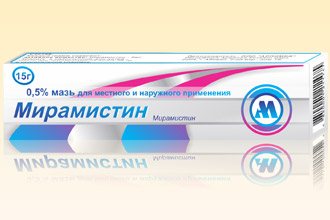
Miramistin is commercially available as an ointment and spray for external use. Its active ingredient benzyldimethyl is active against many bacteria, both gram-negative (Escherichia, Pseudomonas) and gram-positive (Staphylococcus, Streptococcus). It destroys the membrane of bacteria, causing their rapid death. It also has an antifungal effect even on crops resistant to most antibiotics.
The active substance is not able to penetrate the skin barrier and mucous membranes of humans. In recent years, a number of studies have also been conducted that confirm the activity of Miramistin against complex viruses, such as the herpes virus and the human immunodeficiency virus.
Manifestations in children's practice
Miramistin is widely used not only in adult, but also in children's practice. According to the manufacturer's instructions, it is recommended to start using it closer to 3 years. However, pediatricians can also prescribe it during infancy, starting from 8 months. Experts justify their choice by the low probability of adverse reactions, and thereby provoking allergies.
Instructions and price for Miramistin
In children, the medication is used only in the form of a spray to treat lesions of the mucous membranes and skin caused by fungi and viruses. Often, children are allergic to the drug due to the immaturity of the immune system. A small organism, not yet formed under the influence of various components of the medications used, can react in a unique way in the form of a specific immune response.
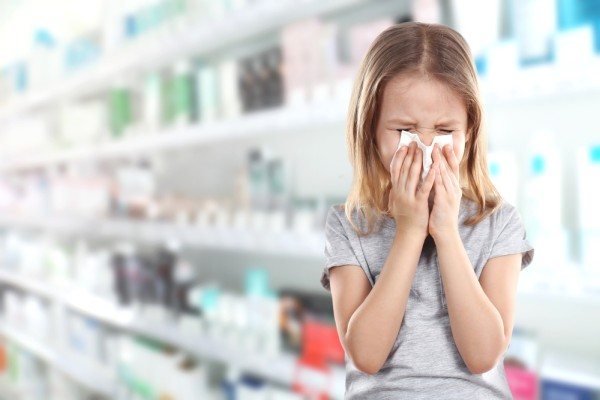
An allergy to Miramistin in an infant may occur if the rules for using the medicine are violated. Cannot be used to relieve a runny nose. For this purpose, products based on soda and salt, industrial medications against rhinorrhea, are optimal.
About the drug
Only two substances are contained in the medicine:
- Miramistin, which is the directly active therapeutic component.
- Distilled water.
The drug belongs to the group of local disinfectants; it destroys most known infectious agents belonging to various classes: bacteria, fungi or viruses.
According to scientific research, the spectrum of action of Miramistin is wide, which leads to its frequent use in medical practice for treating mucous membranes, rinsing the mouth or disinfecting damaged skin. It is believed that the medication is safe for the human body and does not cause side effects except for a local allergic reaction.
Find out why a rash appears after poisoning: causes and treatment.
What to do if weakness appears after poisoning: treatment during the recovery period.
ethnoscience
Among folk remedies, you can use solutions of chamomile and calendula in the form of lotions. They will relieve redness and soreness. To prepare the solution you will need: 2 tablespoons of chamomile or calendula herb, 200 ml of hot water. Brew for 20 minutes, strain the broth, use when cooled to room temperature. Apply lotions 3-4 times a day until redness and itching go away. Apply using a sterile cotton swab.
To relieve itching, it is recommended to use a decoction of oak, birch and linden bark.
Protection against food poisoning
The sea and the sun are the main attractions of both wonderful feelings and possible threats that await independent travelers to exotic countries.
In second place among the possible troubles are water and food.
When arriving in Egypt, India, Sri Lanka or another southern country, do not under any circumstances drink unboiled tap water! Even when brushing your teeth, it is recommended to use bottled water. Alternative options for purchasing purchased water are boiling (for this you need to have a boiler or kettle) or disinfecting drinking water using sterilizing tablets.
Remember - you shouldn’t save on water , otherwise you risk spending your holiday near the bathroom in a hotel room or guesthouse!
Purchased fruits and vegetables must be thoroughly washed using bottled or boiled water.
During acclimatization, you should not get carried away with exotic food that is unusual for your body. antiseptic wipes or liquid with you .
There is a worldview that alcohol helps disinfect food. But instead, you can use, for example, lemon or hot seasoning, which are an integral part of most exotic dishes.
Alternatively, if problems could not be avoided - you have been poisoned, and this is accompanied by vomiting or diarrhea - the first aid kit must certainly contain drugs such as activated charcoal or enterosgel, loperamide or immodium (caution: contraindicated for children and pregnant women!).
If digestive disorders are associated with overeating or food that aggravated acquired diseases of the stomach, liver or pancreas, Maalox, Festal or Panzinorm, No-Spa will help you. And, of course, moderation in food, as well as avoidance of alcohol.
The essence of the disease
Most often, an allergy to a drug occurs with a severe overdose. In this situation, the components of the medicine really begin to cause harm, they pose a danger to the body, and the immune system works correctly, producing histamine. But this does not change the situation; allergies are guaranteed.
In addition, a reaction occurs if Miramistin is used for other purposes. This product is intended for external use, so if you try to drink the contents of the bottle, you will hardly be able to avoid unpleasant consequences.
The hereditary factor plays a significant role. The fact is that sensitivity to various compounds is transmitted genetically from parents to children. If the mother suffered from an allergy to the components of Miramistin, then with some degree of probability the child will also suffer from this disease. Moreover, such allergies are the most difficult to treat, since the immune system is “sick” not due to temporary reasons, but at the genetic level.
Healing with a catch. Allergy to ceftriaxone
Diagnostics
Signs of drug allergies are:
- Previous contact with the drug (with initial use, symptoms appear no earlier than 6 days).
- The reaction occurs even with a minimal dose of the drug.
- The manifestations fit into the “classic” allergy symptoms.
- After discontinuation of the drug, there is a decrease in symptoms up to complete absence.
Skin tests
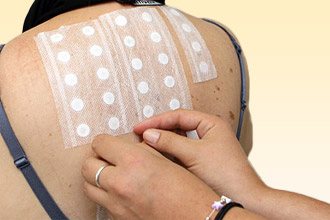
The technique consists of applying subcutaneous, intranasal, or inhalation minimal doses of the drug and monitoring the patient’s condition under the supervision of allergists and resuscitators. If the reaction is positive, it appears within 30 minutes. The appointment of skin tests must be justified, since they are provocative tests.
Features of the course in children
The prevalence of drug allergies in children ranges from 1 to 8%. Since more and more drugs are produced every year, the likelihood of atopy increases proportionally, even with a relatively harmless medication.
We should not forget that symptoms similar to allergies can occur in children with infectious diseases (measles, scarlet fever).
Overdiagnosis and lifelong refusal of the drug without sufficient grounds also often occur. This leads to the prescription of more complex analogues and a potential increase in allergenicity of the child’s body.
First of all, it should be understood that the prescription of the medication must be strictly according to indications and not exceed the age norm. Miramistin is indicated for children from 3 years of age, but can be prescribed to infants (from 6 months) with:
- Acute pharyngitis
- Acute tonsillitis
- Gingivitis
- Stomatitis
- External inflammatory diseases
In children, allergies to miramistin can occur in several types. The first type is similar to the course of allergies in adults and is characterized by more severe symptoms:
- Urticaria manifests itself not only at the site of application, but also in a generalized manner;
- Contact dermatitis has a risk of becoming chronic;
- Inhalation administration may provoke bronchial asthma;
- Allergic rhinitis and conjunctivitis are characterized by more pronounced manifestations;
- Dangerous conditions (anaphylaxis and angioedema) develop faster.
Before using Miramistin, first apply the drug to a small area of skin on the child’s arm. If no rashes, redness, or itching appears on the skin within 3 hours, the likelihood of an allergic reaction is minimal.
The second type of reaction is characterized by more severe manifestations, but occurs extremely rarely, since Miramistin practically does not come into contact with the blood. Manifests:
- Autoimmune anemia;
- Leukopenia;
- Thrombocytopenia.
Symptoms
How does an allergy to Miramistin manifest itself? Drug susceptibility is indicated by very characteristic signs. Among the symptoms of an allergic reaction, local and general manifestations are distinguished. Directly at the site of exposure to the drug, redness may be observed, which is accompanied by itching and burning, similar to symptoms of burns. In some cases, allergies on the skin can lead to a polymorphic rash, blisters and even hives.
Systemic manifestations mainly include the occurrence of imbalances in the respiratory and digestive systems. A cough may appear, which is accompanied by rhinorrhea. Rhinitis with an allergy to miramistin is a fairly common occurrence. Stool becomes irregular, manifesting as constipation or diarrhea. Allergies also include periodic abdominal pain, increased gas formation, and colic.
